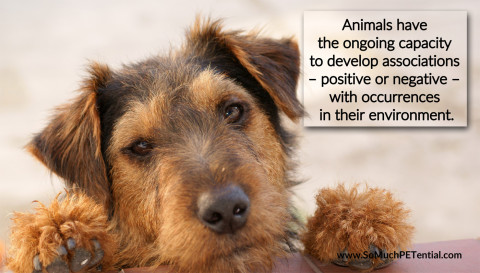I talk a lot about how animals learn from their consequences; and how, those immediate consequences of their behaviors are what determine the future rate of those behaviors. In scientific terms, this is called operant learning or operant conditioning.
 However, there is another type of learning that is also very important to understand when it comes to helping our pets – and our relationship with them – to succeed. It is called classical conditioning, a reflexive type of learning where one stimulus acquires the capacity to evoke the same response as another stimulus.
However, there is another type of learning that is also very important to understand when it comes to helping our pets – and our relationship with them – to succeed. It is called classical conditioning, a reflexive type of learning where one stimulus acquires the capacity to evoke the same response as another stimulus.
Russian physiologist Ivan Pavlov first taught us about classical conditioning when he measured the salivation response to dogs being fed. In his famous experiment, he gave his dogs food and also rang a bell. After numerous repetitions, he rang the bell on its own without food and found that the dogs still responded with an increase in salivation. The bell, which began as a neutral stimulus, had become a conditioned stimulus.
This video gives a cute demonstration of how classical conditioning works.
Why is this such an important concept to understand? Because just as our pets are continually learning whether or not to repeat behaviors based upon whether those behaviors serve to get them a consequence of value; they also have the ongoing capacity to develop associations – positive or negative – with occurrences in their environment.
As I have heard trainer Kathy Sdao say numerous times, the emotional response to the second stimulus infects the emotional response to the first stimulus occurring just before.
The examples of this can be endless. The clicker which initially has no meaning to the animal, only acquires a positive response from the animal after it is repeatedly paired (with the clicker sound coming first) with a consequence of value to the animal. The sight of a leash acquires a positive response after repeatedly being paired with an outing.
Equally important to understand is that something your dog initially has a positive response to like a piece of chicken or favorite toy, can also take on a negative response if it is repeatedly shown just BEFORE something negative. I have seen dogs come to put their tail down and walk away as their owner begins making a stuffed kong, when the kong is only given to the dog after being put into a crate and left there for eight hours (if the dog has a negative association with being in its crate). Many dogs begin to pant heavily, shake and seek shelter when they feel an air pressure shift as that air pressure shift has come to be associated with feared thunder storms. When an owner jerks his dog’s leash as another dog approaches in anticipation of his own dog’s barking and lunging behavior, his dog my begin having even more heightened heart rate and attention to that other approaching dog as it has come to be associated with a leash jerk.
Here is another reason why understanding this can help or hinder you in your training. Think about the ultimate chain of events – you give a cue, your pet does a behavior, and then that behavior is followed by a consequence. Each step of the first two steps is immediately followed by a consequence, and thus has the power to cause the same response as the event that occurs immediately after it.
In other words, with enough pairing, your pet’s behavior will cause the same response (whether that is an emotional response, salivation or other) as its consequence. AND the cue then, with enough pairing, will cause the same response as its consequence (with is the behavior).
When you train using positive reinforcement (with let’s say a clicker or verbal marker) then everything about that lesson is about causing positive responses. The food given at the end of the chain infects the marker which infects the behavior which infects the cue. And so the cue then takes on the same reflexive response for your student of salivation, energy release, mental stimulation, etc.
If you are wanting to build strong behaviors and have success in your training, it is important that your cues always are predictors of good things for your learner.
If, on the other hand, you give a cue, your pet does the behavior (or does not immediately do the behavior), and something negative occurs, then everything in that chain can become associated with something aversive. An example of this is if you call your dog to come and he ignores you, and the consequence is receiving a shock (remote collar) which causes your dog to feel pain and to jump. Then ultimately sniffing the flowers (or whatever your dog was doing at the time) and your cue have the potential of being associated with a feeling of pain and jumping.
This is one of the ways that taught behaviors can break down and cues can be weakened – or at least can work to cause your dog to not want to learn from you because it causes unpleasant things to happen.
My challenge to you is this: if you want your dog to do what you cue it to do without hesitation and with a tail wag, then take care to make sure that cue is only associated with positive outcomes.






